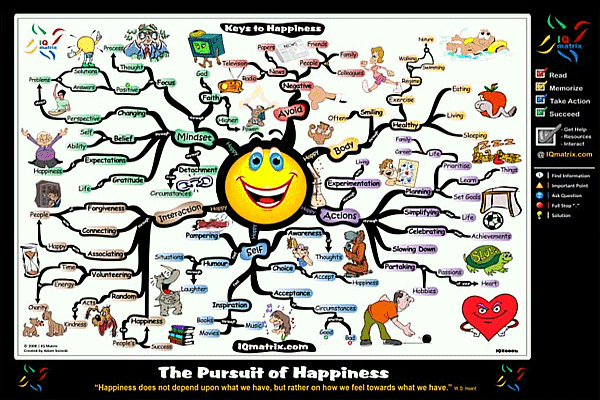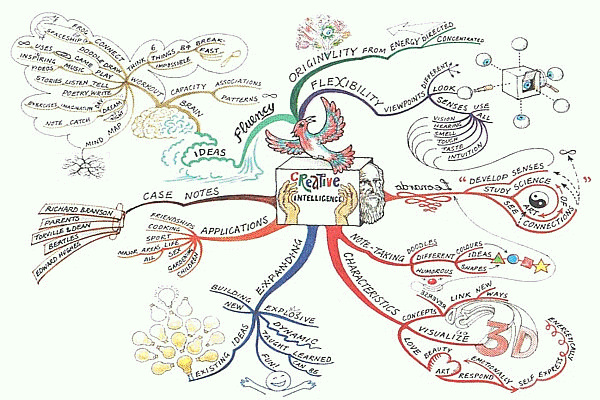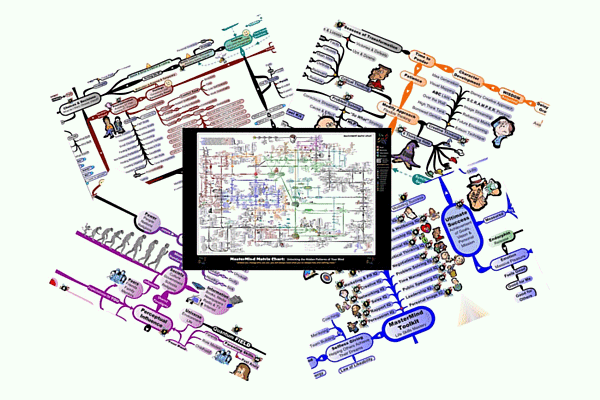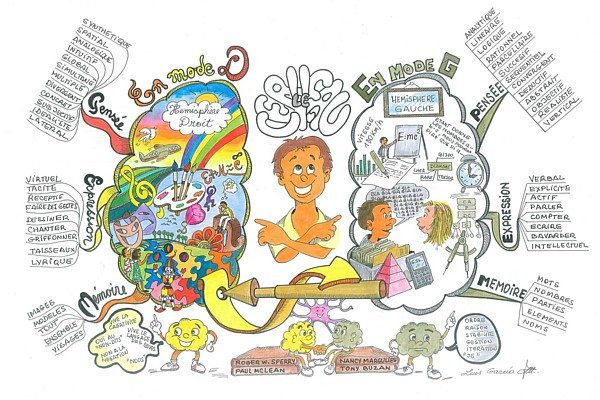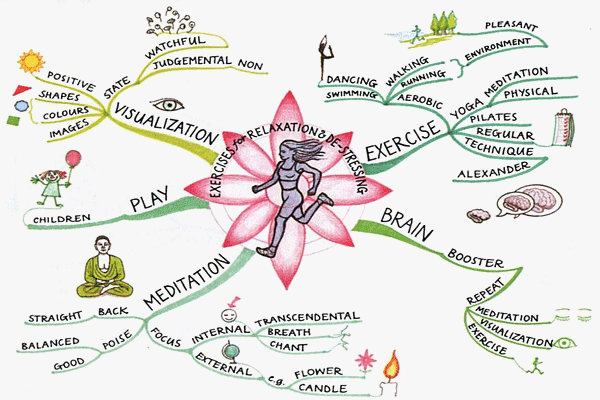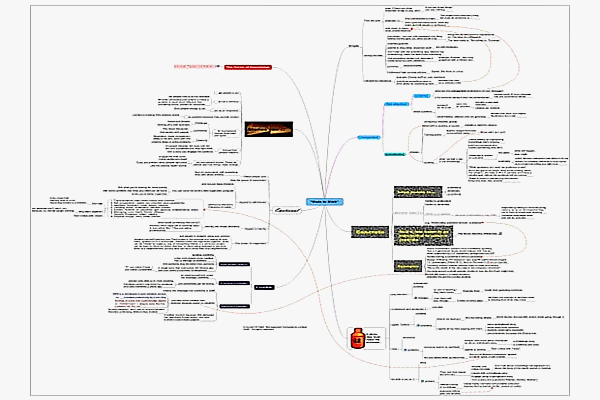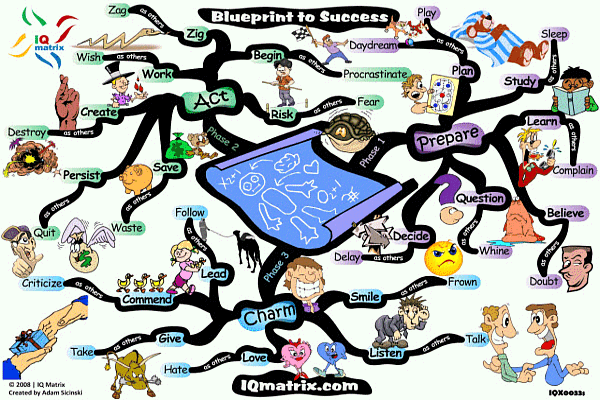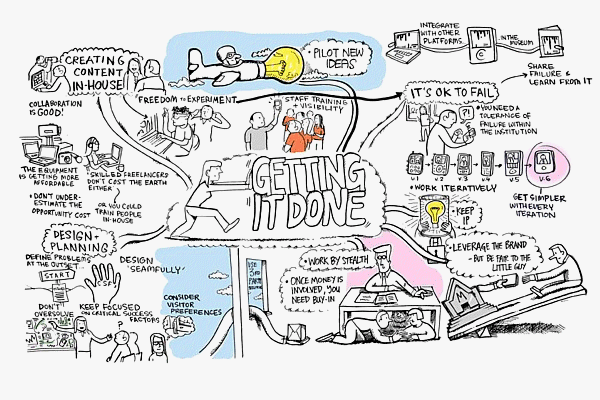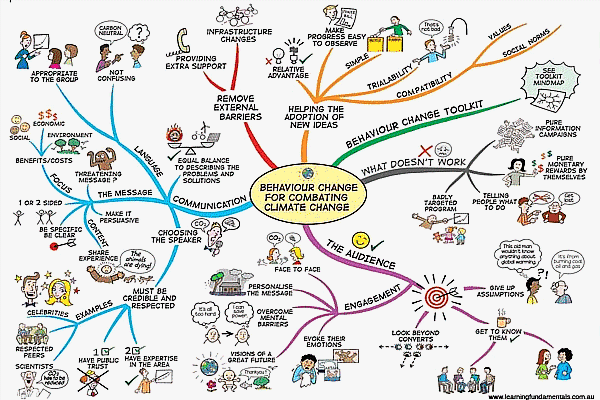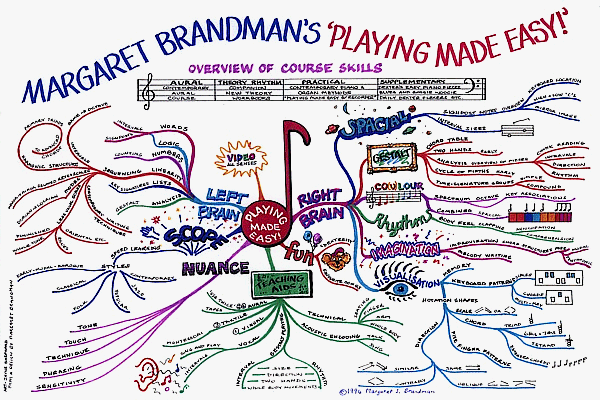My personal favourite Mind Maps
There are dozens of wonderful Mind Map examples around the World all helping to combat information overload and provide us with excellent learning opportunities. The visual impact of Mind Maps can be striking in so many different and often unique ways, with diverse styles and formats working equally well.
As more Maps get created around the World I may add to the list. The examples below will help you to explore some exciting Mind Maps and see some excellent techniques being used. The order is not of great significance as all of the Mind Maps are wonderful in their own way. I hope this list helps inspire you in your own mindmapping.
1. Creative Intelligence Mind Map by Alan & Emily Burton
The Creative Intelligence Mind Map by Alan & Emily Burton displays a wonderful blend of artistic skill, colour and imagination. This Mind Map shares many original and inspiring elements including the following:
- Brilliant use of colours, shapes, images, arrows, symbols and space
- Mixture of upper and lower case lettering
- Use of flowing fonts and mixing images with lettering
- Mirror writing
- Clever inversion of letters (such as the word “originality”)
- Use of 3D
- Morphing a branch into an image and back into a branch again
- Using a boundary (top left)
- Mixture of different size, shape, direction and design of branches
- Movement and freshness; eye-catching, exciting and memorable
Compare reading the above all-be-it very useful list of some of the key elements of the Mind Map with viewing the Mind Map itself and instantly you can see the benefits of mindmapping!
There are many great illustrations in this Mind Map yet even if you were to view it and imagine it with no images you can see the way the design cleverly flows and radiates outwards from the central image.
2. MasterMind Matrix by Adam Sicinski
In my brief review of Adam Sicinski’s MasterMind Matrix I described the Matrix as Google Earth for the brain.
The MasterMind Matrix is like a bigger picture overview of the human condition, from which many Mind Maps have been and are being created by Adam. The Matrix is an exceptional piece of work and I feel it takes not only the Mind Map concept to a whole new level yet also our understanding of what it is like being human and where we can make improvements for a richer and fuller life. I highly recommend you visit Adam’s Blog Post to learn more about the MasterMind Matrix.
3. Brain Metaphor Mind Map by Luis Garcia
The Brain Metaphor Mind Map by Luis Garcia makes a stunning use of colour, illustrations and also space. This Mind Map presents a highly artistic overview of the brain functions. I like the contrast of the rigidness of the straight lines and formal feel of the paler illustrations against the flowing, colourful and highly creative side. The character in the central image cleverly points to each side and there are nice overlap techniques bringing 3D to the Mind Map. The contained colours of the formal side help explode the colourful elements and make it extremely eye-catching.
An interesting exercise to do here is to cover each side and view the other independently – it helps appreciate the way the Mind Map is constructed and also highlights how you actually feel when reading the different sides in the contrasting styles and colours.
4. Exercises for Relaxation by Tony Buzan
The Exercises for Relaxation Mind Map by Tony Buzan shows an excellent use of space and has a great central image. The hierarchal branch sizes radiating outwards and neatly printed lettering make the Mind Map very easy to read. The Mind Map also shows that using shades and tints, lights and darks, even with similar colours works really well.
5. Made to Stick Mind Map by Roy Grubb
The Made to Stick Mind Map by Roy Grubb is an excellent example of the use of mindmapping software – I’ve included this in the list for two reasons. Firstly because I didn’t want to solely represent hand-drawn mindmapping when there are also hundreds of extremely useful and well-presented examples of computer generated Mind Maps available to view across the internet. Secondly, because this Mind Map explores brilliantly a book called “Made to Stick” by Chip & Dan Heath and is a great example of taming information and presenting it to learn from and revisit.
The Mind Map is available for viewing in a variety of formats – visit the information tamers website to take a look in greater detail.
6. Blueprint to Success Mind Map by Adam Sicinski
The Blueprint to Success Mind Map by Adam Sicinski is a brilliant example of using mindmapping to inspire and make positive change; this is a Mind Map that instantly brings you back to being on purpose. I like the way Adam has used just threes branches to present the information and the way he has used contrasting actions or feelings to highlight where our focus may be at any given time. To learn more visit the full explanatory Blog Post of the Blueprint to Success Mind Map.
7. The Pursuit of Happiness Mind Map by Adam Sicinski
The Pursuit of Happiness Mind Map by Adam Sicinski is another great example of using mindmapping to share knowledge, inspire others and help make positive change. Brilliant use of colour and images and this time presented as a striking Motivational poster with key codes, symbols and reading tips provided at the side to aid comprehension. The full Blog Post expands further on the Pursuit of Happiness Mind Map.
8. Getting it Done Mind Map by Dan Porter & James Baylay
The Getting it Done Mind Map by Dan Porter & James Baylay is a highly artistic presentation of information. Wonderful illustrations; each image area is like an individual cartoon (I love the light bulb aeroplane!) The occasional use of colour also works really well. Visit the Mind Map Art website to see more about the Getting it Done Mind Map plus links to others by Dan & James
9. Behaviour Change for Climate Change Mind Map by Jane Genovese
The Behaviour on Climates Mind Map by Jane Genovese combines excellent illustrations and stylish branches, capturing important points for combating climate change. The breaks in the branches are an effective way to introduce additional images and phrases and the use of light colours works extremely well. The Behaviour on Climates Mind Map and other Mind Maps by Jane Genovese can be seen at Mind Map Art with links to other websites containing her work.
10. Playing Made Easy Mind Map created by Margaret Brandman
The Playing Made Easy Mind Map created by Margaret Brandman and drawn to her specifications by artist Jayne Shephard is a great example of using Mindmapping as a learning tool. The text and images within branches is a great idea. The flowing branches add to the musical feel and the overall look of the Mind Map just makes you want to learn more. I also like the way a heading and overview has been added above the main body of the Mind Map.

